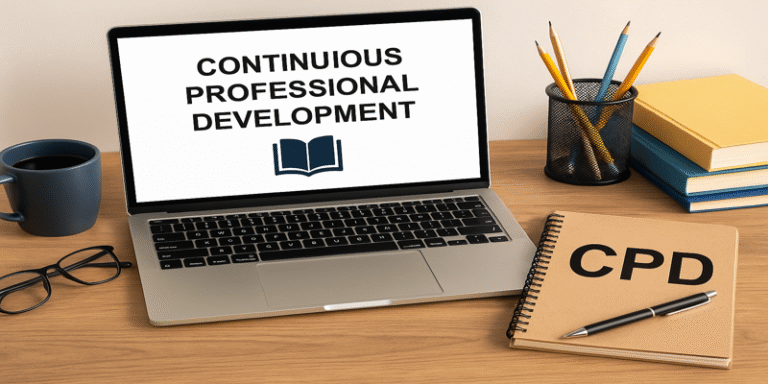In an era defined by rapid technological, regulatory, and societal change, Continuous Professional Development (CPD) has become an indispensable strategy for professionals seeking to remain relevant, competent, and competitive. CPD refers to the ongoing, intentional, and self-directed process of acquiring new knowledge, refining skills, and enhancing professional competencies. This article explores the importance of CPD, its core elements, and how it promotes proactive career management in today’s dynamic work environment.
1.0 Lifelong Learning: The Foundation of CPD
The essence of CPD lies in lifelong learning—a commitment to continuous growth beyond formal education. Unlike traditional models that prioritised one-time qualifications, modern careers demand that professionals keep pace with evolving knowledge and technologies. As Daley et al. (2010) argue, professionals must engage in learning that is continuous and context-specific, allowing them to respond to industry advancements.
For example, healthcare professionals often participate in workshops and online modules to remain updated on clinical guidelines. Similarly, tech workers must regularly refresh their understanding of emerging tools, languages, and security protocols.
Lifelong learning also signals employability. Employers value individuals who take initiative to stay informed, as this reflects adaptability and self-motivation (Hager & Holland, 2006). In doing so, CPD aligns individual goals with organisational needs.
2.0 Skill Enhancement: Technical and Interpersonal Competence
CPD supports both the acquisition of new competencies and the refinement of existing skills. While technical knowledge is essential, today’s job market also demands soft skills such as communication, collaboration, and emotional intelligence. For instance, a finance professional may attend courses on data analytics, while also pursuing leadership training.
As Kidd and Hounsell (2007) note, structured CPD can significantly improve the quality of professional services. In particular, digital literacy, critical thinking, and problem-solving have become priority skills due to automation and artificial intelligence.
Employers increasingly assess job candidates on their capacity to learn and adapt, making CPD a practical tool for career resilience in a volatile job landscape.
3.0 Reflective Practice: Encouraging Self-Awareness
A core element of CPD is reflective practice, a process through which individuals evaluate their experiences, identify learning needs, and set development goals. Schön (1983) describes this as learning through and from experience to better understand one’s actions and their outcomes.
For example, a teacher reflecting on classroom outcomes might realise the need for training in inclusive pedagogy. Reflective journals, peer feedback, and self-assessment tools are commonly used to facilitate this process.
Reflective practice promotes a growth mindset, encouraging professionals to view challenges as opportunities for development rather than as setbacks (McLachlan, 2006).
4.0 Staying Informed: Navigating Industry Trends
Modern industries are shaped by frequent technological innovations and regulatory shifts. CPD ensures professionals remain aligned with current best practices. According to Lave and Wenger (1991), situated learning—learning embedded in social and professional contexts—enables individuals to respond to change proactively.
For example, financial analysts must stay updated on new compliance laws and trading technologies. Similarly, educators are expected to integrate digital tools and inclusive strategies in pedagogy.
Staying updated not only improves performance and relevance, but also prevents skill stagnation in a competitive marketplace.
5.0 Networking and Collaboration: Social Learning in Action
CPD often involves interacting with peers, mentors, and industry leaders at seminars, workshops, and professional communities. These platforms offer more than knowledge—they foster networks that support collaboration and innovation.
Brown and Duguid (2000) assert that knowledge sharing is essential to professional growth. Through CPD, professionals can engage in cooperative learning, access mentorship, and exchange diverse perspectives.
For instance, participating in a CPD-accredited conference allows engineers to gain insights into both technical advancements and strategic decision-making from industry veterans.
6.0 Regulatory Compliance: A Professional Obligation
In many regulated industries, CPD is not optional. Mandatory CPD is enforced to ensure that professionals meet licensing, ethical, and safety standards. This is common in healthcare, law, education, and finance.
Failure to comply can result in loss of certification, fines, or legal repercussions. McLachlan (2006) emphasises that compliance-driven CPD also encourages ethical practice, as professionals remain accountable to their clients and governing bodies.
For example, UK nurses are required by the Nursing and Midwifery Council to log 35 hours of CPD every three years to retain registration.
7.0 Career Progression: Unlocking Opportunities
Professionals who invest in CPD often enjoy greater job mobility, higher salaries, and faster promotions. CPD enhances career capital—a combination of skills, reputation, and experience that improves employability.
As Tynjälä (2013) explains, learning that connects theory with practice equips individuals to take on complex roles. For instance, an IT specialist pursuing cybersecurity certifications can transition into a specialised role with greater responsibility and remuneration.
Moreover, employees who demonstrate initiative in learning are more likely to be considered for leadership roles or cross-functional projects.
8.0 Adaptability: Thriving Amid Change
Adaptability—the capacity to adjust to new conditions—is a hallmark of modern professionalism. CPD fosters this trait by promoting learning agility and open-mindedness. In rapidly shifting sectors such as healthcare or education, adaptability can distinguish between career growth and redundancy.
Billett (2001) identifies workplace learning as a key to managing transitions, such as adopting new systems, managing crises, or shifting to remote work.
For example, during the COVID-19 pandemic, many professionals used CPD platforms to quickly gain digital facilitation skills, enabling them to work effectively online.
Continuous Professional Development (CPD) represents more than a training strategy—it is a holistic, self-directed approach to lifelong learning and career sustainability. By embracing CPD, professionals can maintain relevance, competence, and resilience in a world marked by rapid change.
From skill enhancement and reflective practice to networking, compliance, and career advancement, CPD serves as a powerful framework for professional empowerment. Ultimately, CPD is not merely a requirement—it is an investment in one’s future success and fulfilment.
References
Billett, S. (2001) Learning in The Workplace: Strategies for Effective Practice. Allen & Unwin.
Brown, J. S. and Duguid, P. (2000) The Social Life of Information. Harvard Business Press.
Daley, B. J., Durning, S. J., Torre, D. and Pangaro, L. N. (2010) ‘The Power of Peer Assessment in Medical Education’, Academic Medicine, 85(11), pp. 1746–1751.
Hager, P. and Holland, S. (2006) Graduate Attributes, Learning and Employability. Springer.
Kidd, J. M. and Hounsell, D. (2007) ‘Enhancing the Effectiveness of Learning and Teaching in Design & Technology’, International Journal of Technology and Design Education, 17(1), pp. 51–65.
Lave, J. and Wenger, E. (1991) Situated Learning: Legitimate Peripheral Participation. Cambridge University Press.
McLachlan, J. C. (2006) ‘Articulate: Promoting Reflection to Support Professional Practice’, in Promoting Legal & Ethical Awareness. pp. 82–94.
Schön, D. A. (1983) The Reflective Practitioner: How Professionals Think in Action. Basic Books.
Tynjälä, P. (2013) ‘Toward A 3-P Model of Workplace Learning: A Literature Review’, Vocations and Learning, 6(1), pp. 11–36.









